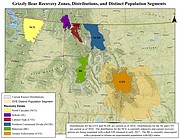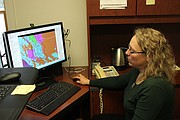If 'threatened' status goes, do grizzlies gain?
For four years, research ecologist Tabitha Graves has studied grizzly bears at the U.S. Geological Survey’s NOROCK West Glacier Field Station.
The hulking ursines bring more than tourists to Northwest Montana. “They have a pretty big role in this ecosystem,” she told the Daily Inter Lake. “We don’t often think about these kinds of details, but they disperse a lot of seeds, [and] they dig a lot,” helping circulate nutrients through the forest floor.
Understanding their benefits requires estimating the number of bears in the region – no easy task in a 16,000-square-mile “demographic monitoring area.” Graves and her colleagues add barbed wire to the tree trunks that bears rub along, then have the hair they collect DNA-sequenced, gaining a sense of which individual bears frequent which spots.
Then, a type of statistical analysis called spatial capture-recapture enables researchers “to estimate the density of bears and to look at how that changes.”
This group, one of several that studies the Northern Continental Divide grizzlies, hopes to finish this research in the next few months. Graves made clear that the results have yet to be finalized, but said that “in our raw data, we are detecting more bears over time.”
This research could soon face intense scrutiny. In September, the U.S. Fish and Wildlife Service cited rising population numbers when it removed grizzlies around Yellowstone National Park from the “threatened” species list, and turned them over to state management.
The decision sparked hope among ranchers, hunters and others who use the land – and outrage from some environmental groups, who have taken the federal government to court.
Meanwhile, federal grizzly bear recovery coordinator Hilary Cooley has said that delisting the Northern Continental Divide population will be considered next year.
This means that Northwest Montana could soon have to consider the benefits and drawbacks of its iconic bear’s “threatened” status.
“What happens next,” Graves said, “will really depend on...the decisions that are made in terms of how bears are managed in the future.”
Ursus Arctos horriblis once roamed from Mexico to Alaska, numbering as high as 50,000 in the continental U.S.
But the bears’ claws and heft proved no match for settlers’ bullets. Hunted and deprived of food and rangeland, the grizzly bear population dwindled. By the mid-1970s, it had dropped to less than 1,000 bears in the lower 48 states, mostly grouped in six Rocky Mountain and Pacific Northwest populations. Northwest Montana is one of the few places where they’re still somewhat close to humans.
In 1975, the federal government moved to stem the decline, listing the continental U.S. bears as “threatened” under the Endangered Species Act.
Doing so made it a crime to kill or harm grizzly bears, except in self-defense. Habitat-disturbing actions on the West’s vast public lands require consultation with the U.S. Fish and Wildlife Service. And when a bear starts poking around Montana farms or subdivisions, state officials must consult with the service before removing it. Grizzly bear recovery plans guided the effort to restore the species to health.
According to the U.S. Fish and Wildlife Service, grizzly bears now number between 1,400 and 1,700. Of six “recovery ecosystems,” Glacier Country’s Northern Continental Divide Ecosystem is the most populous, estimated to hold 765 bears. Farther south, the Yellowstone Ecosystem is estimated at 690.
“It’s really hard to pick just one thing,” that has driven the recovery, Graves said. But “stopping hunting and decreasing mortality from and managing for human-bear conflicts has been a huge part of that.”
But several environmental groups say that a loss of the “threatened” status could sap the recovery’s momentum.
“I think we’re skeptical that the states would manage it well,” says Andrea Santarsiere, senior attorney for the Center for Biological Diversity.
The Center, like other groups suing the federal government, sees multiple issues with the delisting decision in the Yellowstone region. But a common concern is that stripping bears’ protections in some areas will weaken the species overall.
Living on a few patches of a once-vast range doesn’t bode well for grizzlies’ long-term survival. It means that genes that could help the bears resist a disease or adapt to a changing climate will stay limited to one part of the Rockies, and that small populations will stay vulnerable.
Graves says that Northwest Montana’s grizzly bear distribution may be shifting south, but they haven’t yet linked up with Yellowstone’s bears.
Santarsiere worries that without federal protections, the states will loosen restrictions on shooting bears in transit.
“There’s not a lot of protection in the potential connectivity corridors,” she said.
This situation stems from a deeper dilemma: As the grizzly population grows and moves, they’ll edge in on areas that humans have developed without them.
Joe Perry with the Montana Sportsmen Alliance has seen this firsthand. In prior years hunting the Bob Marshall Wilderness, “we never saw a bear, never had any trouble in camp.”
“Now,” he continues, “all of us look over our shoulder, [and] most of us carry bear spray, even when you’re hunting.”
Deer and elk harvests for the FWP’s Region 1 are slightly down from their numbers a decade ago, but there’s been major year-to-year variation, and Perry says bears “haven’t had major impacts on game populations.”
But for cattle ranchers, the trend could prove serious.
“There has been a significant increase in grizzly bear depredations” of livestock, Jay Bodner, natural resources director for the Montana Stockgrowers Association, told the Daily Inter Lake. As grizzly bears expand, “they’re looking for additional food sources, and a lot of those times cattle and calves are subject to depredation.”
State data show that over the past decade, livestock losses to bears and wolves have ranged between 100 and 300 per year. Bodner says delisting could streamline the response to these incidents, removing the need for federal consultation before bears get relocated.
But some conservationists fear that post-delisting, states could give lethal methods a boost.
Despite federal protections, a 2011 Montana law states that “a person may not kill or attempt to kill a grizzly bear unless the grizzly bear is in the act of attacking or killing livestock.”
After delisting, trophy hunting could also occur, but state officials stress that it would be extremely restricted. Yearly hunts could only take place if mortality targets were not exceeded, and the quota would be split between hunters from Montana, Idaho and Wyoming.
Drawing on these statutes and recent studies — including findings that about half of all grizzly deaths result from human conflict — the Center’s lawsuit over the Yellowstone bears argues that “there is an unacceptable risk that the bear population will decline below recovery goals soon after delisting.”
Do the Flathead Valley’s resident bears face that risk?
“I think we would be facing the same problems with delisting grizzly bears in the Northern Continental Divide Ecosystem” as with Yellowstone, Santarsiere told the Daily Inter Lake.
But a few factors separate the two groups. A decline in whitebark pine may have driven Yellowstone’s bears to seek other food sources, including livestock. But Graves said that “we don’t have one food that’s as dominant across the entire system, and we don’t have a food that’s as clearly in decline out here.”
And so far, humans and bears here have lived in relative peace. Tim Manley, who has helped manage the area’s grizzly bears for Montana Fish, Wildlife and Parks since 1993, says conflicts go “up and down.”
Most of the problems he deals with — grizzlies “getting into garbage, birdseed, maybe killing chickens” — are low-carnage. Lethal force, he emphasizes, is a “last resort.”
And the Endangered Species Act hasn’t kept him from removing bears. He says consultation with Fish and Wildlife Service is “very quick. Basically it’s a matter of a phone call...I can’t think of any situation where they didn’t agree with our recommendation.”
Recent years’ mortality numbers have hovered in the 20s and 30s. From 2004 to 2014, Fish, Wildlife and Parks estimates that the bear population grew at an annual rate of 2.3 percent.
The study now being prepared in the USGS’s small West Glacier station will update knowledge of these animals and be taken into account as the Fish and Wildlife Service weighs delisting.
This process, and its legal and political spats, adds another layer of complexity to an already-intricate ecosystem.
“The population can grow when you don’t kill animals, it can grow through high reproduction, so that’s tied to food resources,” Graves explains. “There’s a lot of different pieces.”
Reporter Patrick Reilly can be reached at preilly@dailyinterlake.com, or at 758-4407.






